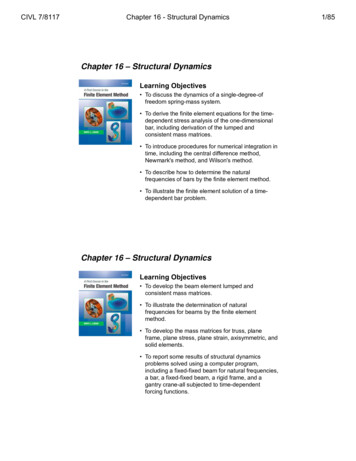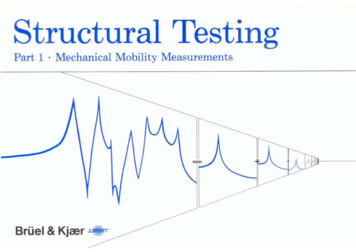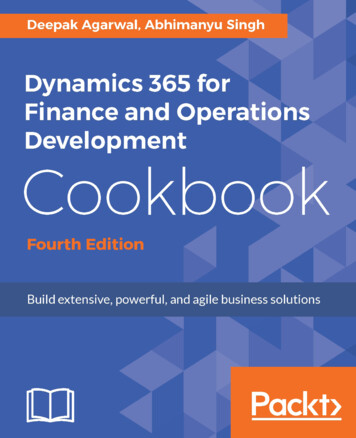
Transcription
CIVL 7/8117Chapter 16 - Structural DynamicsChapter 16 – Structural DynamicsLearning Objectives To discuss the dynamics of a single-degree-offreedom spring-mass system. To derive the finite element equations for the timedependent stress analysis of the one-dimensionalbar, including derivation of the lumped andconsistent mass matrices. To introduce procedures for numerical integration intime, including the central difference method,Newmark's method, and Wilson's method. To describe how to determine the naturalfrequencies of bars by the finite element method. To illustrate the finite element solution of a timedependent bar problem.Chapter 16 – Structural DynamicsLearning Objectives To develop the beam element lumped andconsistent mass matrices. To illustrate the determination of naturalfrequencies for beams by the finite elementmethod. To develop the mass matrices for truss, planeframe, plane stress, plane strain, axisymmetric, andsolid elements. To report some results of structural dynamicsproblems solved using a computer program,including a fixed-fixed beam for natural frequencies,a bar, a fixed-fixed beam, a rigid frame, and agantry crane-all subjected to time-dependentforcing functions.1/85
CIVL 7/8117Chapter 16 - Structural DynamicsStructural DynamicsIntroductionThis chapter provides an elementary introduction to timedependent problems.We will introduce the basic concepts using the singledegree-of-freedom spring-mass system.We will include discussion of the stress analysis of the onedimensional bar, beam, truss, and plane frame.Structural DynamicsIntroductionWe will provide the basic equations necessary for structuraldynamic analysis and develop both the lumped- and theconsistent-mass matrices involved in the analyses of a bar,beam, truss, and plane frame.We will describe the assembly of the global mass matrix fortruss and plane frame analysis and then present numericalintegration methods for handling the time derivative.We will provide longhand solutions for the determination of thenatural frequencies for bars and beams, and then illustrate thetime-step integration process involved with the stress analysisof a bar subjected to a time dependent forcing function.2/85
CIVL 7/8117Chapter 16 - Structural DynamicsStructural DynamicsDynamics of a Spring-Mass SystemIn this section, we will discuss the motion of a single-degree-offreedom spring-mass system as an introduction to thedynamic behavior of bars, trusses, and frames.Consider the single-degree-of-freedom spring-mass systemsubjected to a time-dependent force F(t) as shown in thefigure below.The term k is the stiffness of the spring and m is the mass of thesystem.Structural DynamicsDynamics of a Spring-Mass SystemThe free-body diagram of the mass is shown below.The spring force T kx and the applied force F(t) act on themass, and the mass-times-acceleration term is shownseparately.Applying Newton’s second law of motion, f ma, to the mass,we obtain the equation of motion in the x direction:F (t ) kx mx where a dot ( ) over a variable indicates differentiation withrespect to time.3/85
CIVL 7/8117Chapter 16 - Structural DynamicsStructural DynamicsDynamics of a Spring-Mass SystemThe standard form of the equation is: mx kx F (t )The above equation is a second-order linear differentialequation whose solution for the displacement consists of ahomogeneous solution and a particular solution.The homogeneous solution is the solution obtained when theright-hand-side is set equal to zero.A number of useful concepts regarding vibrations are availablewhen considering the free vibration of a mass; that is whenF(t) 0.Structural DynamicsDynamics of a Spring-Mass SystemLet’s define the following term: 2 kmThe equation of motion becomes: x 2 x 0where is called the natural circular frequency of the freevibration of the mass (radians per second).Note that the natural frequency depends on the spring stiffnessk and the mass m of the body.4/85
CIVL 7/8117Chapter 16 - Structural DynamicsStructural DynamicsDynamics of a Spring-Mass SystemThe motion described by the homogeneous equation of motionis called simple harmonic motion. A typical displacement time curve is shown below.where xm denotes the maximum displacement (or amplitudeof the vibration).Structural DynamicsDynamics of a Spring-Mass SystemThe time interval required for the mass to complete one fullcycle of motion is called the period of the vibration (inseconds) and is defined as:2 The frequency in hertz (Hz 1/s) is f 1/ /(2 ).5/85
CIVL 7/8117Chapter 16 - Structural DynamicsStructural DynamicsDynamics of a Spring-Mass SystemStructural DynamicsDynamics of a Spring-Mass System6/85
CIVL 7/8117Chapter 16 - Structural DynamicsStructural DynamicsDynamics of a Spring-Mass SystemStructural DynamicsDynamics of a Spring-Mass System7/85
CIVL 7/8117Chapter 16 - Structural DynamicsStructural DynamicsDynamics of a Spring-Mass SystemStructural DynamicsDynamics of a Spring-Mass System8/85
CIVL 7/8117Chapter 16 - Structural Dynamics9/85Structural DynamicsDirect Derivation of the Bar ElementLet’s derive the finite element equations for a time-dependent(dynamic) stress analysis of a one-dimensional bar.Step 1 - Select Element TypeWe will consider the linear bar element shown below.where the bar is of length L, cross-sectional area A, and massdensity (with typical units of lb-s2/in4), with nodes 1 and 2subjected to external time-dependent loads: fx e (t )Structural DynamicsDirect Derivation of the Bar ElementStep 2 - Select a Displacement FunctionA linear displacement function is assumed in the x direction.u a1 a2 xThe number of coefficients in the displacement function, ai, isequal to the total number of degrees of freedom associatedwith the element.We can express the displacement function in terms of the shapefunctions: u u N1 N2 1 u2 N1 1 xLN2 xL
CIVL 7/8117Chapter 16 - Structural DynamicsStructural DynamicsDirect Derivation of the Bar ElementStep 3 - Define the Strain/Displacement and Stress/StrainRelationshipsThe stress-displacement relationship is: x du [B ] d dx 1where: [B ] L1 L u1 u2 d The stress-strain relationship is given as: x [D] x [D][B ] d Structural DynamicsDirect Derivation of the Bar ElementStep 4 - Derive the Element Stiffness Matrix and EquationsThe bar element is typically not in equilibrium under a timedependent force; hence, f1x f2x.We must apply Newton’s second law of motion, f ma, to eachnode.Write the law of motion as the external force fxe minus theinternal force equal to the nodal mass times acceleration.10/85
CIVL 7/8117Chapter 16 - Structural Dynamics11/85Structural DynamicsDirect Derivation of the Bar ElementStep 4 - Derive the Element Stiffness Matrix and EquationsTherefore:f1x e f1x m1where:m1 2u1 t 2 AL2f2 x e f2 x m2 2u2 t 2 ALm2 2Mass lumped to the nodes f1x e f1x m1 e f2 x f2 x 0 2u1 0 t 2 m2 2u2 t 2 Structural DynamicsDirect Derivation of the Bar ElementStep 4 - Derive the Element Stiffness Matrix and EquationsIf we replace {f} with [k]{d} we get: f (t ) k d m d eWhere the elemental stiffness matrix is:AE k L 1 1 1 1 and the lumped-mass matrix is: m AL 1 0 2 0 1 2 d d t 2
CIVL 7/8117Chapter 16 - Structural DynamicsStructural DynamicsDirect Derivation of the Bar ElementStep 4 - Derive the Element Stiffness Matrix and EquationsLet’s derive the consistent-mass matrix for a bar element.The typical method for deriving the consistent-mass matrix isthe principle of virtual work; however, an even simplerapproach is to use D’Alembert’s principle.The effective body force is: X u eThe nodal forces associated with {Xe} are found by using thefollowing: fb [N ]T { X } dVVStructural DynamicsDirect Derivation of the Bar ElementStep 4 - Derive the Element Stiffness Matrix and EquationsSubstituting {Xe} for {X} gives: fb [N ]T u dVVThe second derivative of the u with respect to time is: u [N ] d u [N ] d where u and u are the nodal velocities and accelerations,respectively.12/85
CIVL 7/8117Chapter 16 - Structural DynamicsStructural DynamicsDirect Derivation of the Bar ElementStep 4 - Derive the Element Stiffness Matrix and EquationsTherefore: fb N N d dV m d TVwhere: m N N dVTVThe mass matrix is called the consistent mass matrix becauseit is derived using the same shape functions use to obtain thestiffness matrix.Structural DynamicsDirect Derivation of the Bar ElementStep 4 - Derive the Element Stiffness Matrix and EquationsSubstituting the shape functions in the above mass matrixequations give: x 1 L x x m x 1 L L dV V L x 1 L x m A x 1 L0 L Lx dxL 13/85
CIVL 7/8117Chapter 16 - Structural Dynamics14/85Structural DynamicsDirect Derivation of the Bar ElementStep 4 - Derive the Element Stiffness Matrix and EquationsSubstituting the shape functions in the above mass matrixequations give:2 x x x 11 L L L L dx m A 2 xxx0 1 L L LEvaluating the above integral gives: m AL 2 1 6 1 2 Structural DynamicsDirect Derivation of the Bar ElementStep 5 - Assemble the Element Equations and IntroduceBoundary ConditionsThe global stiffness matrix and the global force vector areassembled using the nodal force equilibrium equations, andforce/deformation and compatibility equations. F (t ) K {d } M d whereN K k (e ) e 1N M m( e ) e 1 F f ( e ) Ne 1
CIVL 7/8117Chapter 16 - Structural DynamicsStructural DynamicsNumerical Integration in TimeWe now introduce procedures for the discretization of theequations of motion with respect to time.These procedures will allow the nodal displacements to bedetermined at different time increments for a given dynamicsystem.The general method used is called direct integration. Thereare two classifications of direct integration: explicit and implicit.We will formulate the equations for two direct integrationmethods.Structural DynamicsNumerical Integration in TimeThe first, and simplest, is an explicit method known as thecentral difference method.The second more complicated but more versatile than thecentral difference method, is an implicit method known as theNewmark-Beta (or Newmark’s) method.The versatility of Newmark’s method is evidenced by itsadaptation in many commercially available computerprograms.15/85
CIVL 7/8117Chapter 16 - Structural Dynamics16/85Structural DynamicsCentral Difference MethodThe central difference method is based on finite differenceexpressions for the derivatives in the equation of motion.For example, consider the velocity and the accelerationat time t: d d i 1 d i 1 2( t )i d i d d i 1i 12( t )where the subscripts indicate the time step for a given timeincrement of t.Structural DynamicsCentral Difference MethodThe acceleration can be expressed in terms of thedisplacements (using a Taylor series expansion).The first two terms of Taylor series of a function d(t) is:d 2d i 1 d i d i t i t 2Solving for the acceleration gives:2 d i 1 d i d i t di 2 t d d i 1 d i 1 i2( t )Substitute the central difference for the first derivation
CIVL 7/8117Chapter 16 - Structural Dynamics17/85Structural DynamicsCentral Difference MethodTherefore, accelerations can be expressed in terms of thedisplacements as: d d i 1 2 d i d i 1 ( t )2iWe generally want to evaluate the nodal displacements;therefore, we rewrite the above equation as: di 1 2 di di 1 d i ( t )2The acceleration can be expressed as: d M F K d 1iiiStructural DynamicsCentral Difference MethodTo develop an expression of di 1, first multiply the nodaldisplacement equation by M and substitute the above equationfor d i into this equation. M di 1 2 M di M di 1 Fi K di t 2Combining terms in the above equations gives:22 M di 1 t Fi 2 M t K di M di 1 To start the computation to determine d i 1 , d i 1 , and d i 1we need the displacement at time step i -1.
CIVL 7/8117Chapter 16 - Structural DynamicsStructural DynamicsCentral Difference MethodUsing the central difference equations for the velocity andacceleration: d d i 1 d i 1 i2( t ) di 1 2( t ) d i di 1 di 1 2 di di 1 d i ( t )2Solving for {di-1} gives: d i 1 d i ( t ) d i d i ( t )22Structural DynamicsCentral Difference MethodProcedure for solution:1. Given: d0 , d 0 , and Fi (t ) 2. If the acceleration is not given, solve for d 0 d M F K d 10003. Solve for {d-1} at t - t( t )2 d 1 d0 ( t ) d0 d02 18/85
CIVL 7/8117Chapter 16 - Structural Dynamics19/85Structural DynamicsCentral Difference MethodProcedure for solution:4. Solve for {d1} at t t using the value of {d-1} from Step 322 M di 1 t Fi 2 M t K di M di 1 d1 M t F0 2 M t K d0 M d 1 122Structural DynamicsCentral Difference MethodProcedure for solution:5. With {d0} given and {d1} determined in Step 4 solve for {d2} d 2 M t F1 2 M t K d1 M d0 122 d M F K d d 6. Solve for d 1 :7. Solve for d 1 : 1111d 2 d0 12( t )8. Repeat Steps 5, 6, and 7 to obtain the displacement,acceleration, and velocity for other time steps.
CIVL 7/8117Chapter 16 - Structural DynamicsStructural DynamicsCentral Difference MethodProcedure for solution:Structural DynamicsCentral Difference Method – Example ProblemDetermine the displacement, acceleration, and velocity at 0.05second time intervals for up to 0.2 seconds for the onedimensional spring-mass system shown in the figure below.Consider the above spring-mass system as a single degree offreedom problem represented by the displacement d.20/85
CIVL 7/8117Chapter 16 - Structural Dynamics21/85Structural DynamicsCentral Difference Method – Example ProblemProcedure for solution: d0 01. At time t 0: d 00 2. If the acceleration is not given, solve for d 0 d M F K d 1000 100(0) 62.83 in d 2,00031.83s02Structural DynamicsCentral Difference Method – Example ProblemProcedure for solution:3. Solve for {d-1} at t - t( t )2 d 1 d0 ( t ) d0 d02 (0.05)2(62.83) 0.0785 in24. Solve for {d1} at t 0.05 s using the value of {d-1} from Step 3 122 d1 M t F0 2 M t K d0 M d 1 d 1 0 (0.05)0 d1 122 0.05 2,000 2 31.83 0.05 100 0 31.83 0.0785 31.82 0.0785 in
CIVL 7/8117Chapter 16 - Structural Dynamics22/85Structural DynamicsCentral Difference Method – Example ProblemProcedure for solution:5. With {d0} given and {d1} determined in Step 4 solve for {d2} d 2 M t F1 2 M t K d1 M d0 1 d 2 22 122 0.05 1,500 2 31.83 0.05 100 0.0785 31.83 0 31.82 0.274 in 6. Solve for d 1 : d M F K d 11111 1,500 100 0.0785 46.88 in d 31.83s1Structural DynamicsCentral Difference Method – Example ProblemProcedure for solution: 7. Solve for d 1 : d d 2 d 0 12( t ) 0 2.74 in d 0.274s2 0.05 18. Repeat Steps 5, 6, and 7 to obtain the displacement,acceleration, and velocity for other time steps.2
CIVL 7/8117Chapter 16 - Structural Dynamics23/85Structural DynamicsCentral Difference Method – Example ProblemProcedure for solution:5. With {d1} given and {d2} determined in Step 4 solve for {d3} d3 M t F2 2 M t K d2 M d1 1 d3 22 122 0.05 1,000 2 31.83 0.05 100 0.274 31.83 0.0785 31.82 0.546 in 6. Solve for d 2 : d M F K d 12221 1,000 100 0.274 30.56 in d 31.83s2Structural DynamicsCentral Difference Method – Example ProblemProcedure for solution: 7. Solve for d 2 : d d3 d1 22( t ) 0.0785 4.68 in d 0.546s2 0.05 28. Repeat Steps 5, 6, and 7 to obtain the displacement,acceleration, and velocity for other time steps.2
CIVL 7/8117Chapter 16 - Structural Dynamics24/85Structural DynamicsCentral Difference Method – Example ProblemThe following table summarizes the results for the remainingtime steps as compared with the exact solution.d i (in/s2) d i (in/s)t (s)F(t) 6.07510.85350.82500.250-3.62525.91741.15391.132di (in)di (exact)Structural DynamicsCentral Difference Method – Example ProblemPlotting the motion for about 4 s 1.522.533.54
CIVL 7/8117Chapter 16 - Structural Dynamics25/85Structural DynamicsNewmark’s MethodNewmark’s equations are given as: d d ( t ) (1 ) d d i 1ii 1i d i 1 d i ( t ) d i ( t )2 21 d i d i 1 where and are parameters.The parameter is typically between 0 and ¼, and is oftentaken to be ½.For example, if 0 and ½ the above equation reduce tothe central difference method.Structural DynamicsNewmark’s MethodTo find {di 1} first multiply the above equation by the mass matrix[M] and substitute the result into this the expression foracceleration. Recall the acceleration is: 1d M F K d iiiThe expression [M]{di 1} is: M di 1 M di ( t ) M d i ( t )2 M 21 d i ( t )2 Fi 1 K d i 1 Combining terms gives: M ( t ) K d ( t ) F M d 22i 1i 1 i ( t ) M d i ( t )2 M 21 d i
CIVL 7/8117Chapter 16 - Structural Dynamics26/85Structural DynamicsNewmark’s MethodDividing the above equation by (Δt)2 gives: K' d i 1 F'i 1 where:1 K ' K ( t )2 M F 'i 1 Fi 1 M d i ( t ) d i 21 ( t )2 d i ( t ) 2The advantages of using Newmark’s method over the centraldifference method are that Newmark’s method can be madeunconditionally stable (if ¼ and ½) and that larger timesteps can be used with better results.Structural DynamicsNewmark’s MethodProcedure for solution:
CIVL 7/8117Chapter 16 - Structural Dynamics27/85Structural DynamicsNewmark’s MethodProcedure for solution:1. Given: d , d , and F (t ) 0 0i 2. If the acceleration is not given, solve for d 0 d M F K d 10003. Solve for {d1} at t 0 K' d1 F'1 Structural DynamicsNewmark’s MethodProcedure for solution: 4. Solve for d 1 -- original Newmark equation for d i 1 rewrittenfor d i 1 : d ( 1t ) d d ( t ) d ( t ) 21210012 d d ( t ) (1 ) d d 5. Solve for d 1100 d 0 16. Repeat Steps 3, 4, and 5 to obtain the displacement,acceleration, and velocity for the next time step.
CIVL 7/8117Chapter 16 - Structural DynamicsStructural DynamicsNewmark’s Method – Example ProblemDetermine the displacement, acceleration, and velocity at 0.1second time intervals for up to 0.5 seconds for the onedimensional spring-mass system shown in the figure below.Consider the above spring-mass system as a single degree offreedom problem represented by the displacement d.Use Newmark’s method with 1/6 and ½.Structural DynamicsNewmark’s Method – Example ProblemProcedure for solution:1. Given: d 0 , d 0 , and Fi (t ) 2. If the acceleration is not given, solve for d 0 d M F K d 100 01 100 70(0) 56.5 in / s 21.7728/85
CIVL 7/8117Chapter 16 - Structural Dynamics29/85Structural DynamicsNewmark’s Method – Example ProblemProcedure for solution: K' d1 F'1 3. Solve for {d1} at t 0.1 s1 K ' K ( t )2 M M d1 1(1.77) 1,132 lb / in21(0.1)6 d0 ( t ) d 0 21 ( t )2 d 0 ( t ) F '1 F1 80 70 2161.77 0 (0.1)0 21 61 (0.1)2 56.5 280 lb2 (0.1) F '1 280 lb K ' 1,132 lb in 0.248 inStructural DynamicsNewmark’s Method – Example ProblemProcedure for solution:4. Solve for d 1 at t 0.1 s d ( 1t )12 16 1 0.248 0 (0.1)0 (0.1)2 21 61 56.5 35.4 in s22 (0.1) d d ( t ) (1 ) d d 5. Solve for d 11 d1 d0 ( t ) d 0 ( t )2 21 d 0 001 0 (0.1) (1 21 )56.5 21 35.4 4.59 in s
CIVL 7/8117Chapter 16 - Structural Dynamics30/85Structural DynamicsNewmark’s Method – Example ProblemProcedure for solution:6. Repeat Steps 3, 4, and 5 to obtain the displacement,acceleration, and velocity for the next time step.Repeating Steps 3, Solve for {d1} at t 0.2 s F '2 F2 60 d2 16 M d1 ( t ) d 1 21 ( t )2 d 1 ( t ) 21.77 0.248 (0.1)4.59 21 61 (0.1)2 35.4 934 lb(0.1)2 F '2 934 0.825 in K ' 1,132Structural DynamicsNewmark’s Method – Example ProblemProcedure for solution:Repeating Step 4: solve for d 1 at t 0.2 s d ( 1t )22 16 d 2 d1 ( t ) d 1 ( t )2 21 d 1 1 0.825 0.248 (0.1)4.59 (0.1)2 21 61 35.4 (0.1)2 1.27 in s2
CIVL 7/8117Chapter 16 - Structural Dynamics31/85Structural DynamicsNewmark’s Method – Example ProblemProcedure for solution: d d ( t ) (1 ) d d 5. Solve for d 22112 4.59 (0.1) (1 21 )35.4 21 1.27 6.42 in sStructural DynamicsNewmark’s Method – Example ProblemProcedure for solution:The following table summarizes the results for the time stepsthrough t 0.5 seconds.100d i (in/s2)56.4972d i 1.6838t (s)F(t) lb0.0di (in)
CIVL 7/8117Chapter 16 - Structural Dynamics32/85Structural DynamicsNewmark’s Method – Example ProblemProcedure for solution:Plotting the motion for about 4 s 0Structural DynamicsNatural Frequencies of a One-Dimensional BarBefore solving the structural stress dynamic analysis problem,let’s consider how to determine the natural frequencies ofcontinuous elements.Natural frequencies are necessary in vibration analysis andimportant when choosing a proper time step for a structuraldynamics analysis.Natural frequencies are obtained by solving the followingequation: M d K d 0
CIVL 7/8117Chapter 16 - Structural DynamicsStructural DynamicsNatural Frequencies of a One-Dimensional BarThe standard solution for {d} is given as: d (t ) d ' ei twhere {d } is the part of the nodal displacement matrix callednatural modes that is assumed to independent of time, i is thestandard imaginary number, and is a natural frequency.Differentiating the above equation twice with respect to timegives:d d ' 2 e i t Substituting the above expressions for {d} and d into theequation of motion gives: M 2 d ' e i t K d ' e i t 0Structural DynamicsNatural Frequencies of a One-Dimensional Bar Combining terms gives: e i t K 2 M d ' 0Since ei t is not zero, then: K M 02The above equations are a set of linear homogeneousequations in terms of displacement mode {d }.There exists a non-trivial solution if and only if the determinantof the coefficient matrix of is zero. K 2 M 033/85
CIVL 7/8117Chapter 16 - Structural DynamicsStructural DynamicsOne-Dimensional Bar - Example ProblemDetermine the first two natural frequencies for the bar shown inthe figure below.Assume the bar has a length 2L, modulus of elasticity E, massdensity , and cross-sectional area A.Structural DynamicsOne-Dimensional Bar - Example ProblemLet’s discretize the bar into two elements each of length L asshown below.We need to develop the stiffness matrix and the mass matrix(either the lumped- mass of the consistent-mass matrix).In general, the consistent-mass matrix has resulted in solutionsthat compare more closely to available analytical andexperimental results than those found using the lumped-massmatrix.34/85
CIVL 7/8117Chapter 16 - Structural Dynamics35/85Structural DynamicsOne-Dimensional Bar - Example ProblemLet’s discretize the bar into two elements each of length L asshown below.However, when performing a long hand solution, theconsistent-mass matrix is more difficult and tedious tocompute; therefore, we will use the lumped-mass matrixin this example.Structural DynamicsOne-Dimensional Bar - Example ProblemLet’s discretize the bar into two elements each of length L asshown below.The elemental stiffness matrices are:122AE 1 1 k(1) L 1 1 AE 1 1 k(2) L 1 1 1The global stiffness matrix is:323 1 1 0 AE K L 1 2 1 0 1 1
CIVL 7/8117Chapter 16 - Structural Dynamics36/85Structural DynamicsOne-Dimensional Bar - Example ProblemLet’s discretize the bar into two elements each of length L asshown below.The lumped-mass matrices are:1 m(1) 22 AL 1 0 2 0 1 m(2) AL 1 0 2 0 1 1The global lumped-mass matrix is: M 323 1 0 0 0 2 0 2 0 0 1 AL Structural DynamicsOne-Dimensional Bar - Example ProblemSubstituting the above stiffness and lumped-mass matrices intothe natural frequency equation: K 2 M d ' 0 and applying the boundary condition {u1} 0 (or {d 1} 0)gives: AE 2 1 AL 2 0 d '2 0 2 2 0 1 d '3 0 L 1 1 Set the determinant of the coefficient matrix equal to zero as:AEL 2 1 AL 2 0 1 1 2 0 1 0 where 2
CIVL 7/8117Chapter 16 - Structural Dynamics37/85Structural DynamicsOne-Dimensional Bar - Example ProblemDividing the above equation by AL and letting E2 0 2 2 2 22 L2gives: 0Evaluating the determinant of the above equations gives: 2 2 1 0.5858 2 3.4142 For comparison, the exact solution gives 0.616 , whereasthe consistent-mass approach yields 0.648 .Structural DynamicsOne-Dimensional Bar - Example ProblemTherefore, for bar elements, the lumped-mass approach canyield results as good as, or even better than, the results fromthe consistent-mass approach.However, the consistent-mass approach can be mathematicallyproven to yield an upper bound on the frequencies, whereasthe lumped-mass approach has no mathematical proof ofboundedness.The first and second natural frequencies are given as: 1 1 0.7654 2 2 1.8478
CIVL 7/8117Chapter 16 - Structural DynamicsStructural DynamicsOne-Dimensional Bar - Example ProblemThe term may be computed as: E30 106 psi 4.12 106 s-222lb.s2 L(0.00073 in.4 )(100in.)Therefore, first and second natural frequencies are: 1 1.56 103 rad / s 2 3.76 103 rad / sStructural DynamicsOne-Dimensional Bar - Example ProblemIn general, an n-degree-of-freedom discrete system has nnatural modes and frequencies.A continuous system actually has an infinite number of naturalmodes and frequencies.The lowest modes and frequencies are approximated mostoften; the higher frequencies are damped out more rapidly andare usually less important.38/85
CIVL 7/8117Chapter 16 - Structural Dynamics39/85Structural DynamicsOne-Dimensional Bar - Example ProblemSubstituting 1 into the following equation AE LGives:0 d '2 0 2 1 2 AL 2 1 1 2 0 1 d ' 0 3 1.4142 d '2(1) d '3(1) 0 d '2(1) 0.7071 d '3(1) 0where the superscripts indicate the natural frequency.It is customary to specify the value of one of the natural modes{d } for a given i or i and solve for the remaining values. 1 than the solution for d '(1) 0.7071For example, if d '(1)32Structural DynamicsOne-Dimensional Bar - Example Problem (2)Similarly, if we substitute 2 and let d '3 1 the solution of theabove equations gives d '(2) 0.70712 The modal responses for the first and second naturalfrequencies are shown in the figure below.The first mode means that the bar is completely in tension orcompression, depending on the excitation direction.
CIVL 7/8117Chapter 16 - Structural DynamicsStructural DynamicsOne-Dimensional Bar - Example Problem (2)Similarly, if we substitute 2 and let d '3 1 the solution of theabove equations gives d '(2) 0.70712 The modal responses for the first and second naturalfrequencies are shown in the figure below.The second mode means that bar is in compression and tensionor in tension and compression.Structural DynamicsOne-Dimensional Bar - Example Problem (2)Similarly, if we substitute 2 and let d '3 1 the solution of theabove equations gives d '(2) 0.70712 The modal responses for the first and second naturalfrequencies are shown in the figure below.40/85
CIVL 7/8117Chapter 16 - Structural Dynamics41/85Structural DynamicsTime-Dependent One-Dimensional Bar - ExampleConsider the one-dimensional bar system shown in the figurebelow.Assume the boundary condition {d1x} 0 and the initialconditions {d0} 0 and d 0 0 Let 0.00073 lb-s2/in.4, A 1 in.2, E 30 x 106 psi, andL 100 in.Structural DynamicsTime-Dependent One-Dimensional Bar - ExampleThe bar will be discretized into two elements as shown below.The elemental stiffness matrices are:122AE 1 1 k(1) L 1 1 AE 1 1 k(2) L 1 1 1The global stiffness matrix is:323 1 1 0
Structural Dynamics Introduction This chapter provides an elementary introduction to time-dependent problems. We will introduce the basic concepts using the single-degree-of-freedom spring-mass system. We will include discussion of the stress analysis of the one-dimensional bar, beam, truss, and plane frame. Structural Dynamics Introduction










